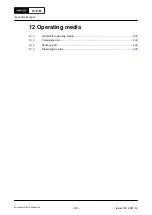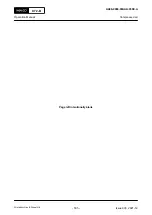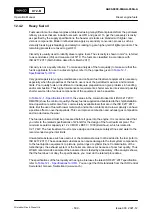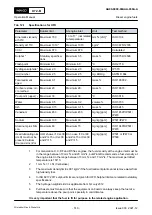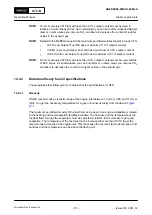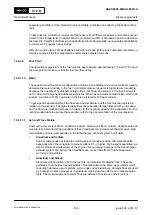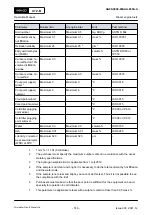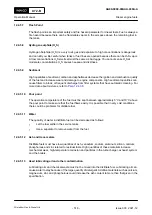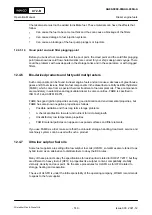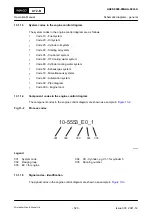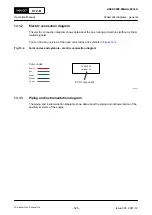
•
Catalytic fines
Catalytic fines cause cylinder liners to become worn. Catalytic fines are attached to water
droplets and are very difficult to remove from the fuel. With correct treatment in the fuel
separator, the aluminum and silicon content of 60 ppm (mg/kg) can be decreased to 15 ppm
(mg/kg), which is thought to be satisfactory. For satisfactory separation, a fuel temperature
as close as possible to 98°C is recommended. A decreased fuel flow rate through the
separator gives a better separation. This is because the fuel stays in the separator for a
longer period. Also obey the instructions of the equipment manufacturer.
Catalytic fines can collect in the sediment of the fuel tank from other bunkers. During bad
weather conditions, the movement of the ship mixes the sediment into the fuel. Thus, it is
better to think that all fuels contain catalytic fines, although it is possible that a fuel analysis
can show a different result. Thus do also regular procedures to remove sludge and catalytic
fines from the fuel that is in the settling tank and the service tanks.
12.4.3.12
Used Lubricating Oil and Chemical Waste
Used lubricating oils and chemical waste must not be mixed into the fuel. If you do so, the fuel
would not be stable because the base oil is very paraffinic and can cause too much sludge. Most
used lubricating oil is from the crankcase, thus large quantities of calcium, zinc, phosphorous and
other additives and wear metals can cause contamination. The limits in ISO 8217:2017 and the
WinGD specifications make sure that no used lubricating oil is in the fuel.
Chemical waste (eg polymers, styrene and other chemical substances) must not be added to the
fuel. These materials can cause the fuel to become too thick, to become almost solid and thus can
cause blocked filters. They can also cause corrosive attacks and damage to the fuel injection
system.
12.4.4
Distillate Fuel Specifications
Since 2015 more frequently distillate fuels are used in 2-stroke engines to obey the new ECA rules.
Distillate fuels are easier to operate than residual fuel, but caution is necessary for some problems.
In ISO 8217:2017 there are specified the DMX, DMA, DMZ and DMB grades and the new DFA,
DFZ and DFB grades with a maximum fatty acid methyl ester (FAME) content of 7.0 volume %.
The WinGD specifications use the DMB grade which is the highest viscosity grade, refer to
12-2 - Specifications for distillate fuels
. The DMX grade is not applicable for use in 2-stroke engines
because of its low flash point and viscosity.
Tab 12-2
Specifications for distillate fuels
Parameter
Bunker limit
At engine inlet
Unit
Test method
Kinematic viscosity
at 40°C
Maximum 11.0
Minimum 2.0
Minimum 2.0 (not re-
lated to temperature)
mm
2
/s [cSt]
1
ISO 3104
Density at 15°C
Maximum 900
Maximum 900
kg/m
3
ISO 3675/12185
Cetane index
Minimum 35
Minimum 35
-
ISO 4264
Sulphur
2
Maximum 1.5
Maximum 1.5
mass %
ISO 8754/14596
Flash point
Minimum 60
Minimum 60
°C
ISO 2719
Hydrogen sulphide
3
Maximum 2.0
Maximum 2.0
mg/kg [ppm]
IP 570
X72-B
AA00-0000-00AAA-030A-A
Operation Manual
Diesel engine fuels
Winterthur Gas & Diesel Ltd.
- 515 -
Issue 003 2021-12
Содержание X72-B
Страница 8: ...X72 B Operation Manual Page left intentionally blank Winterthur Gas Diesel Ltd 8 Issue 003 2021 12...
Страница 18: ...X72 B Operation Manual Page left intentionally blank Winterthur Gas Diesel Ltd 18 Issue 003 2021 12...
Страница 137: ...X72 B Operation Manual Page left intentionally blank Winterthur Gas Diesel Ltd 137 Issue 003 2021 12...
Страница 301: ...7 Installation 7 1 Installation 302 X72 B Operation Manual Winterthur Gas Diesel Ltd 301 Issue 003 2021 12...

